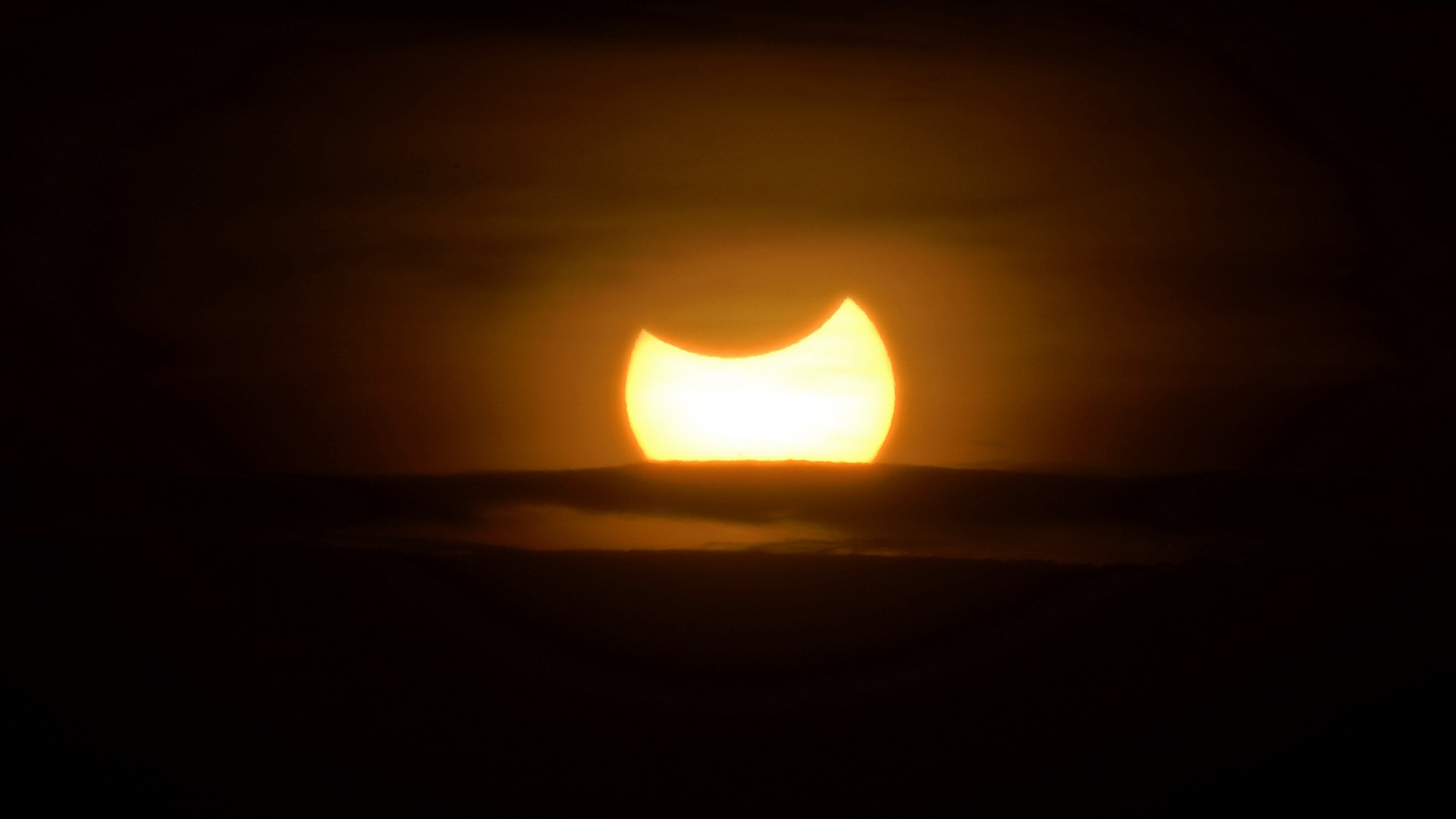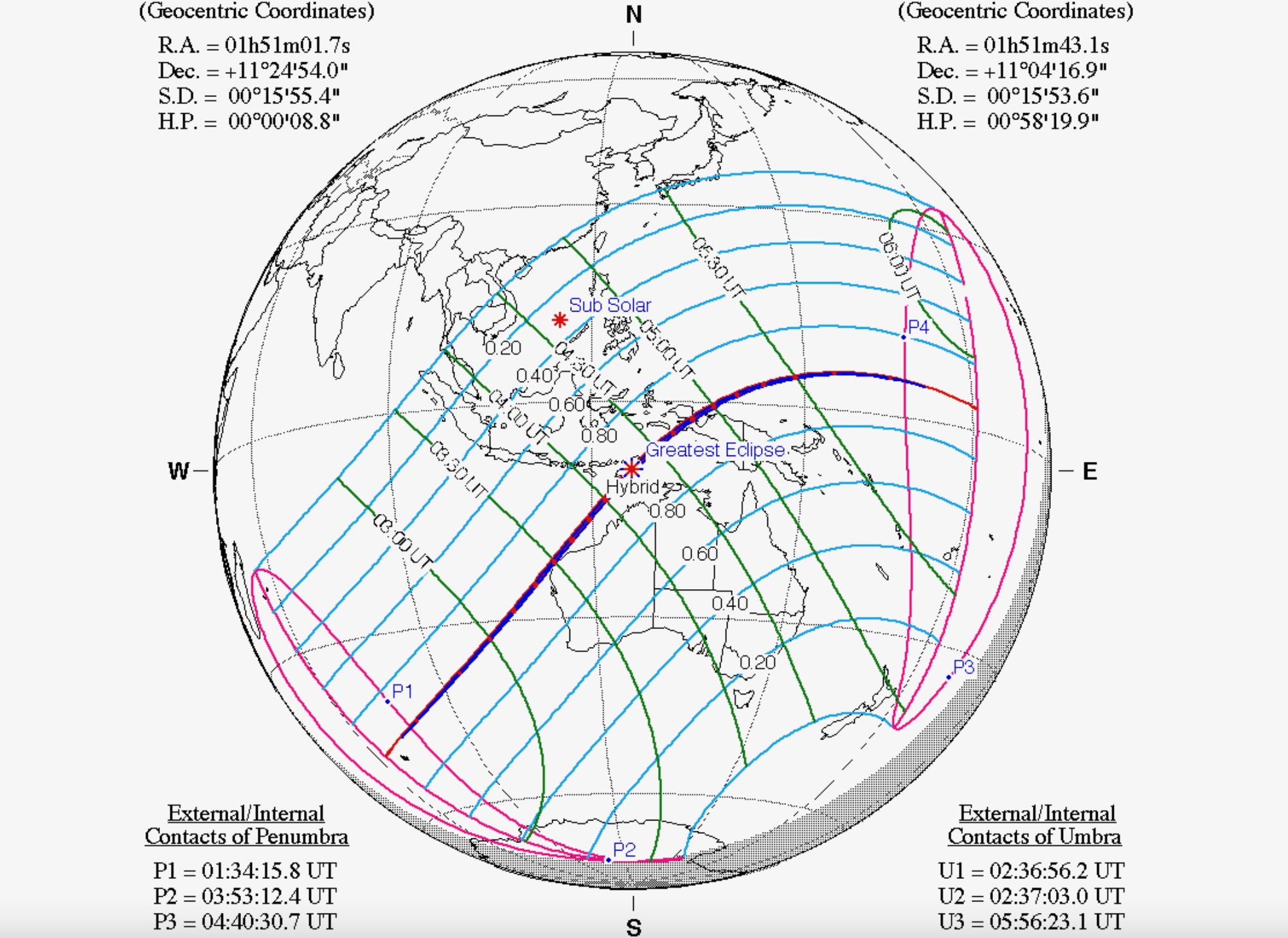The moon blocks the sun in a rare hybrid solar eclipse today
The moon's shadow will sweep across the globe in Western Australia, East Timor and Indonesia.

On Wednesday (April 19) and Thursday (April 20), the moon will pass in front of the sun creating an eclipse for certain regions of the planet. But this eclipse will be a much rarer celestial event than most, as it will be a hybrid eclipse that appears different from different locations across the globe taking the form of an annular eclipse, a total eclipse, or a partial eclipse.
The shadow of the moon will sweep across Western Australia, to East Timor, and Indonesia beginning at 9:36 p.m. EDT on April 19 (0136 GMT on April 20), and ending at 2:59 a.m. EDT (0659 GMT), and as it does the eclipse will change from a ring-shaped annular eclipse to a total eclipse and then back again.
Many more countries will experience the hybrid solar eclipse as a partial eclipse with the moon obscuring just part of the sun, however. These include Papua New Guinea which will see around 87% of the sun eclipsed, the French Southern Territories from where the sun will be 93% covered, and the Marshall Islands which will see 95% of the sun obscured by the moon. The hybrid eclipse won't be visible at all from the continental United States. Luckily, there are a number of livestreams available to help you watch the hybrid solar eclipse online for free.
Related: Hybrid solar eclipse: Everything you need to know about the rare and strange phenomenon
According to In the Sky, the total and annular eclipses will be visible from Australia between 11:29 p.m. to 11:35 p.m. EDT on April 19 (0329 to 0335 GMT on April 20), from East Timor between 12:19 to 12:22 a.m. EDT (0419 to 0422 GMT) on April 20, and from Indonesia from 12:23 a.m. to 12:58 a.m. EDT (0423 to 0458 GMT) on April 20.
Prior to April 2023's hybrid eclipse, the last time one of these rare celestial events occurred was in November 2013, an the next hybrid won't happen until November 2031. The next time one of these events will be visible from the contiguous U.S. will be in March 2164, In the Sky writes.
Hybrid eclipses occur as the result of two factors, the curvature of the Earth and the fact that the moon's shadow is made up of two parts: The shallower and lighter outer shadow called the penumbra, and the darker inner shadow known as the umbra.
Breaking space news, the latest updates on rocket launches, skywatching events and more!
During a hybrid eclipse when the moon's shadow falls on Earth, the planet is only in the penumbra and an annular eclipse is seen. The umbra is over the surface of the Earth. As the moon's shadow slides over the surface of the planet, however, the curvature of Earth causes the surface of the planet to "rise up" to the umbra. Wherever the umbra hits Earth, these regions experience a total eclipse.
"The moon is just at the right distance from Earth for the apex of its cone-shaped shadow to be slightly above the Earth's surface at the beginning and end of the eclipse path, causing the moon's antumbral shadow to move across Earth, causing an annular solar eclipse," Space.com's Jamie Carter wrote in an explainer about the April 20 hybrid eclipse. "However, in the middle of the eclipse path, the apex of the moon's umbral shadow strikes Earth's surface because that part of the planet is slightly closer to the moon."
These hybrid eclipses often have a second "turning point" where the total eclipse reverts back to an annular eclipse. This is caused by the surface of the Earth once again falling away from the dark umbra to the penumbra as the planet continues to curve. In the case of the April 2023 hybrid eclipse, Carter pointed out there will be two points on Earth where the eclipse morphs from an annular eclipse to a total eclipse and back again. These changing points will be at remote locales in the middle of the ocean, however.
It's very important to remember to never look at the sun with the unaided eye. Even during total solar eclipses, looking at the sun without eye protection can permanently harm your eyes and vision. Be sure to check out our guide on how to observe the sun safely if you plan on viewing an eclipse.
Celestron EclipSmart 10x42 Solar Viewing Binoculars
These aren't any ordinary binoculars from Celestron, but multi-coated solar safe binoculars with BK-7 optics and ISO 12312–2 compliant for solar observing. View the sun safely for under $100.
For looking at eclipses safely, check out these solar eclipse glasses and solar filters that comply with international safety standards.
Another easy way to observe the sun safely is with a pinhole camera, a device you can make yourself with materials found around the home.
And if you're looking to take photos of an eclipse or any other celestial spectacle, check out our guide on how to photograph a solar eclipse, as well as our best cameras for astrophotography and best lenses for astrophotography.
Editor's Note: If you snap an image of the hybrid eclipse and would like to share it with Space.com's readers, send your photo(s), comments, and your name and location to spacephotos@space.com.
Follow us @Spacedotcom, or on Facebook and Instagram.

Robert Lea is a science journalist in the U.K. whose articles have been published in Physics World, New Scientist, Astronomy Magazine, All About Space, Newsweek and ZME Science. He also writes about science communication for Elsevier and the European Journal of Physics. Rob holds a bachelor of science degree in physics and astronomy from the U.K.’s Open University. Follow him on Twitter @sciencef1rst.


